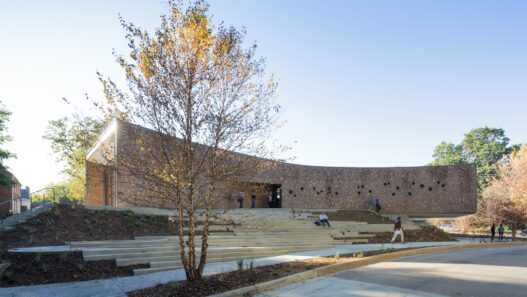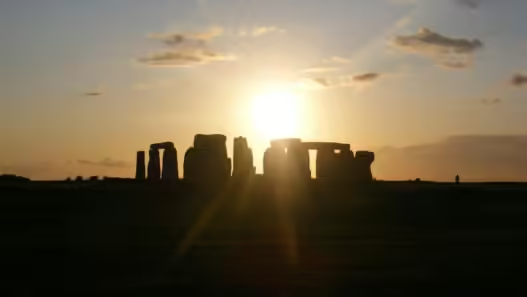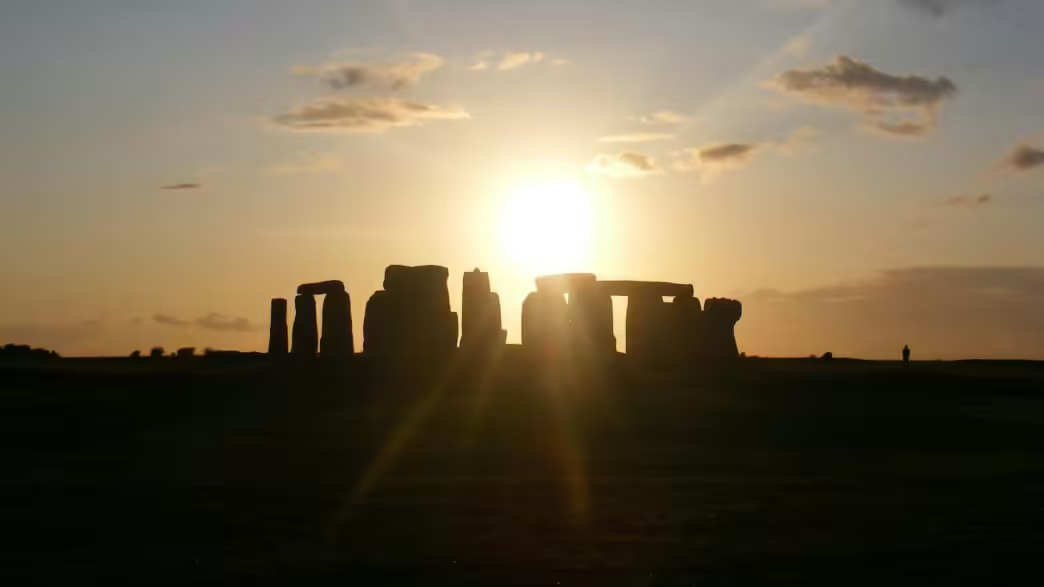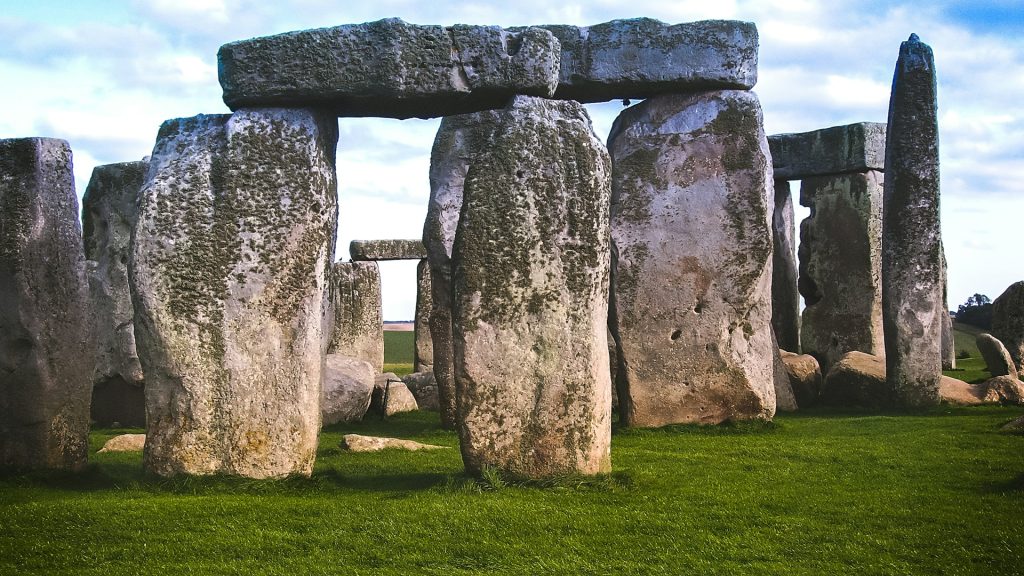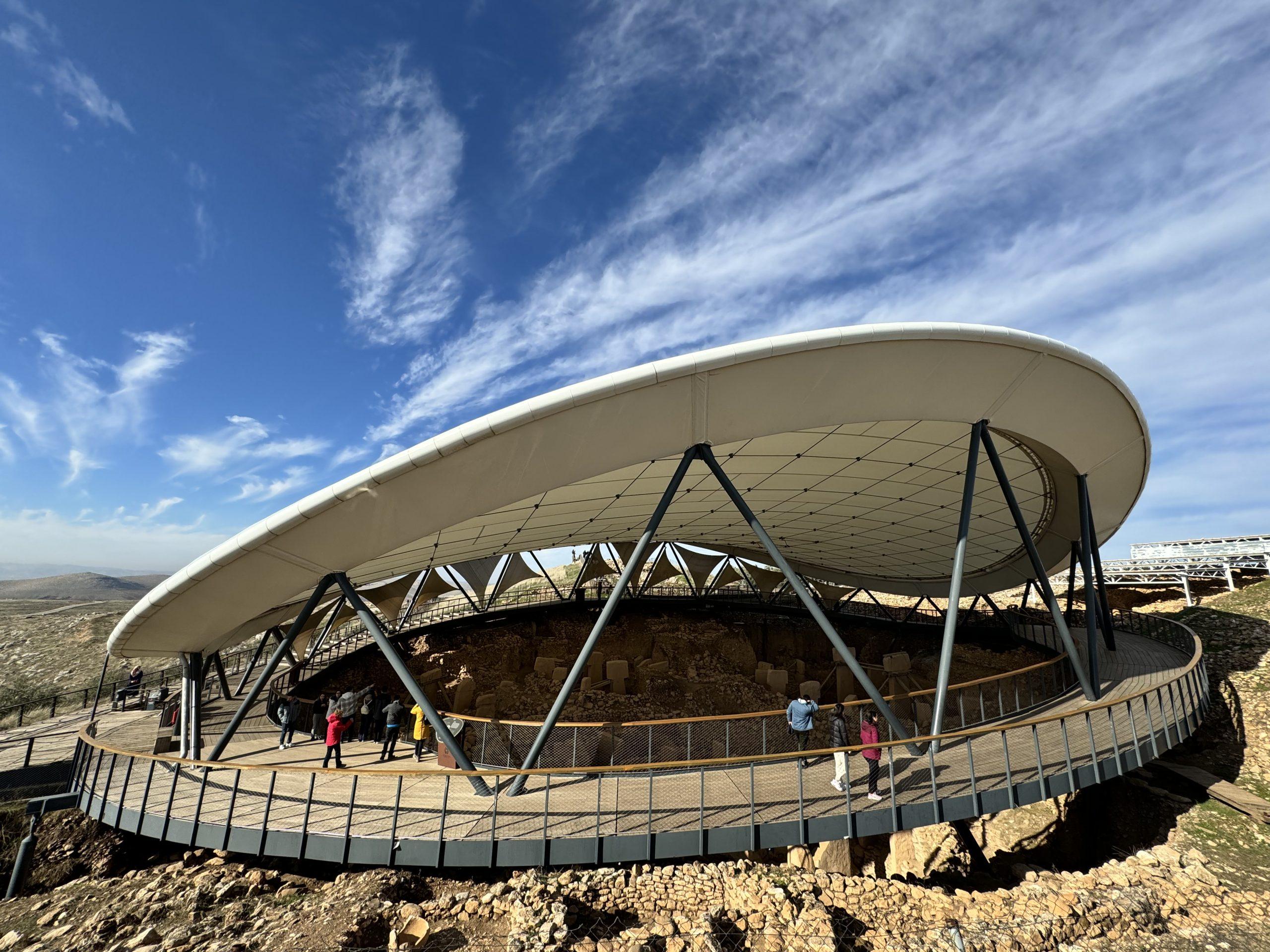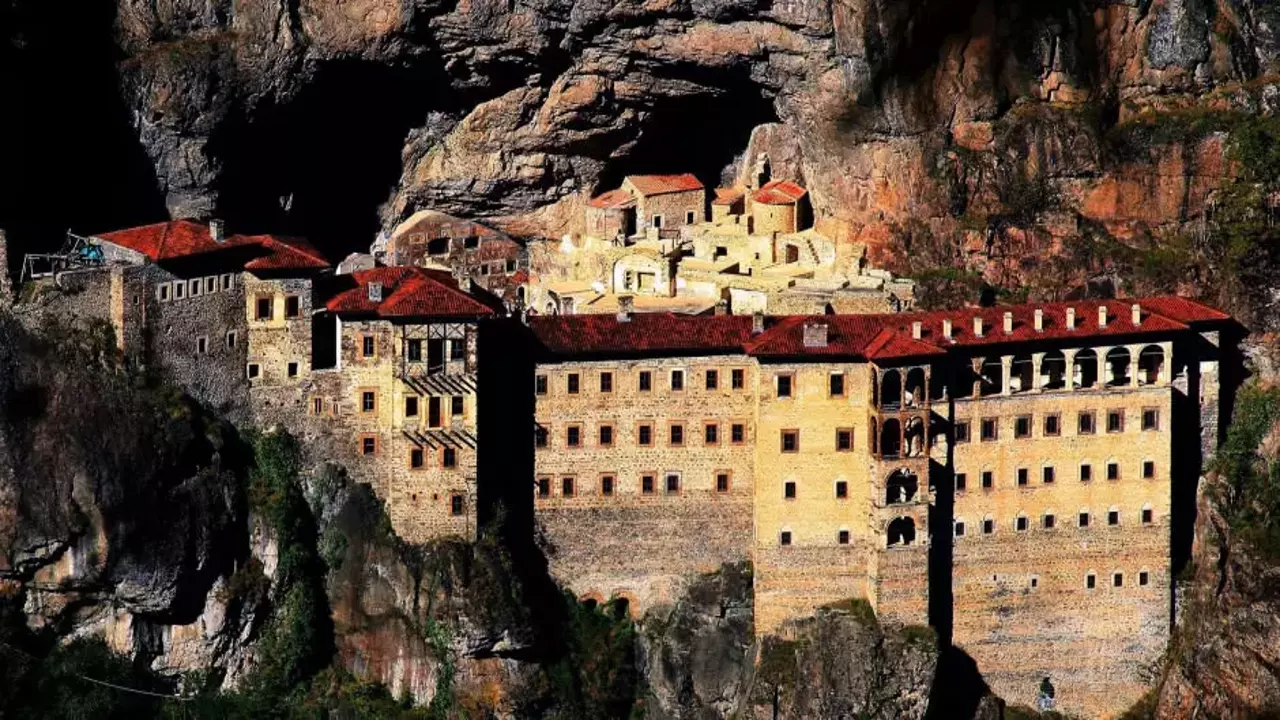Stonehenge is an archaeological site and world heritage site on Salisbury Plain in southern England, famous for its massive stone structures. This ancient structure, which sheds light on human history, has been the subject of curiosity and controversy for thousands of years. Although at first glance it looks like a simple ring of stones, the true meaning and purpose of Stonehenge is still not fully understood.
Stonehenge’s prehistoric origins date back to 3000 BC. This fascinating structure, built by humans in those times, continues to fascinate archaeologists and historians today. However, there are still many debates and theories about the exact purpose of Stonehenge and how it was built.
Many scholars believe that Stonehenge was used as a kind of temple or observatory for astronomical observations. Some claim that it was used to mark the turning points of the sun and make calendar calculations, while others argue that it was used for religious or ceremonial purposes. However, the true purpose of Stonehenge is still not known for certain and research is ongoing.
Stonehenge is also an architectural marvel. The giant stones are a great mystery as to how they were transported and placed thousands of years ago. It is still not understood how they were transported and processed from places as far away as the Preseli Hills, the source of the stones. This provides important clues as to how organized and technologically advanced people were at the time.
Stonehenge is not only an archaeological site, but also has a mystical atmosphere. For thousands of years, visitors have come here to contemplate, admire and speculate on this ancient structure. Today, Stonehenge serves as a popular tourist destination for visitors and a center of prehistoric mystery.
Let’s explore this magnificent historical site together.
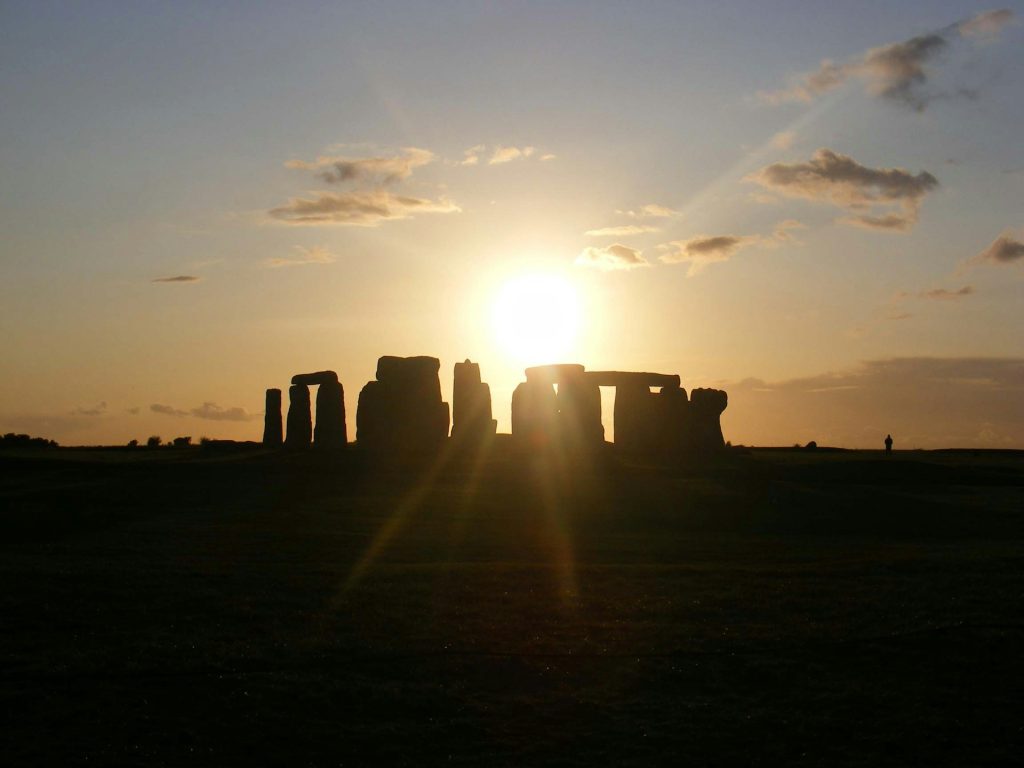
Historical Origins of Stonehenge
The historical origins of Stonehenge have been studied by researchers for many years and various theories have been put forward. It is still unclear exactly when and why this ancient monument was built. However, thanks to archaeological studies and finds, it is thought that Stonehenge was built between approximately 3000 and 2000 BC and belongs to the Neolithic period.
There are different theories about the historical origins of Stonehenge. Some researchers argue that Stonehenge was used as an observation and calendar tool according to the solar and lunar cycles, while others suggest that it was built for religious and ceremonial purposes. Stonehenge is thought to have functioned as a social center and a place for rituals.
Archaeological excavations and scientific research are ongoing to learn more about the historical origins of Stonehenge. These studies aim to provide clearer information about the purpose and meaning of Stonehenge’s construction.
Geographical Location of Stonehenge
Stonehenge is a megalithic monument in Wiltshire in southwest England. Geographically located on Salisbury Plain, Stonehenge is one of the region’s best-known and most visited archaeological sites.
Stonehenge’s location, size and remarkable stone structures have aroused curiosity and admiration for centuries. The place where the monument was built was located at a strategic point in ancient times and was an important geographical crossing point.
“Stonehenge is at a geographically important crossroads with many rivers, roads and megalithic monuments around it. This location may have influenced people’s choice of Stonehenge as a place to build.”
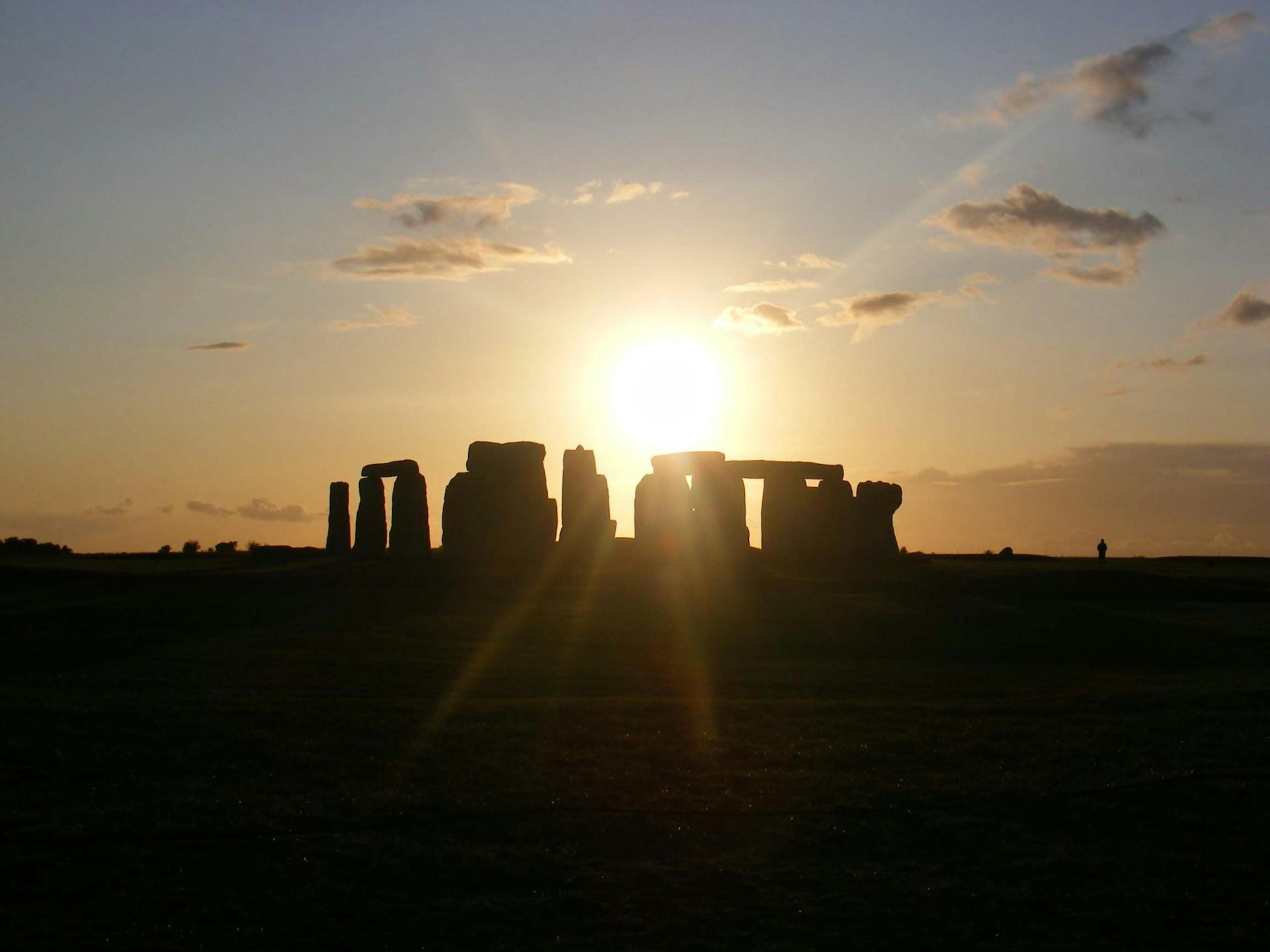




However, Stonehenge’s geographical location is not only a strategic crossing point, but also plays an important role in tracking the sun and moon. Some of the monument’s stones are aligned to track sunrise and sunset, the winter and summer equinox and other astronomical events.
Stonehenge’s geographical location is also of great importance to tourists visiting the site. The spectacular natural beauty and historical richness of Salisbury Plain impresses everyone who visits the area. In addition, the other historic sites and accommodation in the area make it even more attractive for tourists to explore.
| Salisbury Plain | Stonehenge | Touristic Facilities |
|---|---|---|
| Natural beauties | Historical and archaeological importance | Hotels and restaurants |
| Strategic geographical location | Astronomical effects | Souvenir shops |
| Other historical sites | Visitor experience | Guided tours |
The Structure and Dimensions of Stonehenge
Stonehenge is an impressive structure made of gigantic stones. The structural features and dimensions of the structure are quite impressive given its size. Located in Wiltshire, England, Stonehenge is known for its famous stone rings. These stone rings are organized as an inner ring of main stones and an outer ring of horizontal and vertical stones connecting them.
The structural features and dimensions of Stonehenge are also very interesting in terms of the construction process and the placement of the stones. The main stones are very large and heavy, some weighing over 25 tons. How these stones were transported and placed is still unknown and is considered a great mystery by researchers.




The dimensions of Stonehenge are also remarkable. The height of the main stones is about 4.5 meters and the outer ring has a diameter of about 30 meters. The shapes in which the stones are arranged and the gaps between them show that the structure was built in a geometric and aesthetic order. These dimensions are an indication of the engineering and construction skills at the time Stonehenge was built.
Stonehenge’s impressive structural features and dimensions have continued to fascinate people for thousands of years. Thousands of tourists visit this mystical structure every year and experience the fascinating atmosphere of Stonehenge.
The Source of the Stones at Stonehenge
Stonehenge is a fascinating archaeological site in Wiltshire, England. However, exactly where the stones at Stonehenge came from and how they were brought there is still a mystery. There are various theories and research about the origin of the stones, but there is no definitive answer.
The large stones at Stonehenge are made of two different types. The stones in the outer ring are made of yellow limestone with a yellowish brown color, while the stones in the inner ring are blue and gray volcanic basalt. The blue and gray stones were brought from the Preseli Hills, about 250 km away. How these large stones were transported over such a great distance remains a mystery.
There are various hypotheses about the method of transportation of these large blocks from the Preseli Hills to Stonehenge. Some researchers suggest that the stones were slid or dragged on a slippery road, while others think that the stones were slid on tree stumps or carried by boats along rivers.
Research into the origin of the stones and their transportation methods is ongoing. As we learn more about the origin of the stones at Stonehenge and how they were brought there, it will be possible to gain a more in-depth understanding of this impressive structure.
| Stone Type | Source |
|---|---|
| Yellow limestone | Quarries in the immediate vicinity |
| Blue and gray basalt | Preseli Hills, Wales |
Past Functions of Stonehenge
Stonehenge has had various functions in different periods throughout history. This ancient structure has been the subject of various theories and interpretations by various researchers and experts. Here are some important points about the functions and meanings of Stonehenge in the past:
1. Religious and Cultural Center
The most widely accepted function of Stonehenge is that it was mainly used as a religious and cultural center. Research shows that some religious ceremonies, rituals such as the celebration of the passage of the seasons and the observation of celestial phenomena were performed at Stonehenge.
2nd Burial Ground
Stonehenge was also used as a burial site during the Neolithic and Bronze Ages. The human remains found during excavations show that this area was used as a cemetery. The location and placement of the burials helped us to understand the social and religious structures of the society.
3. Observation and Calendar
There is evidence that Stonehenge was used to monitor lunar and solar events and to make calendar calculations. It is thought that some stones were placed to mark targeted celestial events. In this way, it was possible to keep track of the time of agricultural or other seasonal events.
4. Social and Political Center
There is also evidence that Stonehenge was used as a social and political center. Research suggests that some individuals, leaders or important personalities of the community gathered at Stonehenge and made decisions.
5. Visual Impression
Stonehenge has influenced many people throughout history and left an important visual impression. The size of the structure, the arrangement of the stones and the surrounding landscape have caused visitors to admire it. Therefore, Stonehenge has not only functional but also aesthetic significance in the past.
| Past Functions | Meanings |
|---|---|
| Religious and Cultural Center | Graduation celebrations, performing ritual ceremonies, monitoring celestial events |
| Burial Ground | Neolithic and Bronze Age cemeteries, social and religious importance of burials |
| Observation and Calendar | Monitoring of lunar and solar events, creation of agricultural calendars |
| Social and Political Center | Gathering of leaders, taking decisions |
Burials and Archaeological Finds at Stonehenge
The burials and archaeological finds found during the archaeological excavations at Stonehenge have deepened the historical and cultural significance of this ancient monument. These finds show that Stonehenge was used for different purposes in different periods and provide important clues about the history of the region.
“The burials at Stonehenge indicate that this site was used as a burial ground. During the excavations, human remains from different periods were found. Analysis of these remains shows that the burials belonged to people from different social classes.” – Archaeologist Jane Smith
- Burials made at Stonehenge in the 3rd millennium BC are thought to be of important personalities who were held in high esteem by the local population.
- Evidence of burials at Stonehenge was also found in the Middle Ages.
- Archaeologists have revealed that Stonehenge was continuously used as a burial ground over the years, which is why the soil level has risen over time.
Archaeological finds include worked stone tools, ceramic ware, jewelry and other objects. These finds help us to understand the impact of Stonehenge on social and cultural life.
| Find Type | Examples |
|---|---|
| Stone Tools | Arrowheads, digging knives, cutting tools |
| Ceramic Ware | Utensils, bowls, ornaments |
| Jewelry | Metal and stone beads, necklaces, bracelets |
| Other Objects | Production materials, ornaments, food scraps |
These finds show that Stonehenge was not only a building, but also a living space. This ancient monument tells us a lot about the beliefs, rituals and daily life of the society at that time.
Astronomical features of Stonehenge
Stonehenge was built not only as an architectural structure, but also with an astronomical purpose. It was carefully designed to track and follow the movements of the Sun and the Moon.
The placement of the stone rings at Stonehenge suggests a calendar used to determine sunrise and sunset and to keep track of the changing seasons. This shows the relationship of ancient people with celestial bodies and their astronomical knowledge.
Relationship with the Sun
Stonehenge’s most famous and remarkable feature is the Great Stone Line, which can follow the rising and setting of the sun. This gigantic set of stones is especially important during the summer and winter solstices, when the sun rises and sets.




The placement of Stonehenge’s sunning stones shows that ancient people took precise measurements to track the movements of the sun. This shows how advanced their astronomical knowledge was.
Dr Elizabeth Johnson, Archaeoastronomy Specialist
Relationship with the Moon
The stone rings at Stonehenge were also designed to track the movements of the Moon. Some researchers think they carefully placed the stones in the ring to show the points where the Moon rose and set.
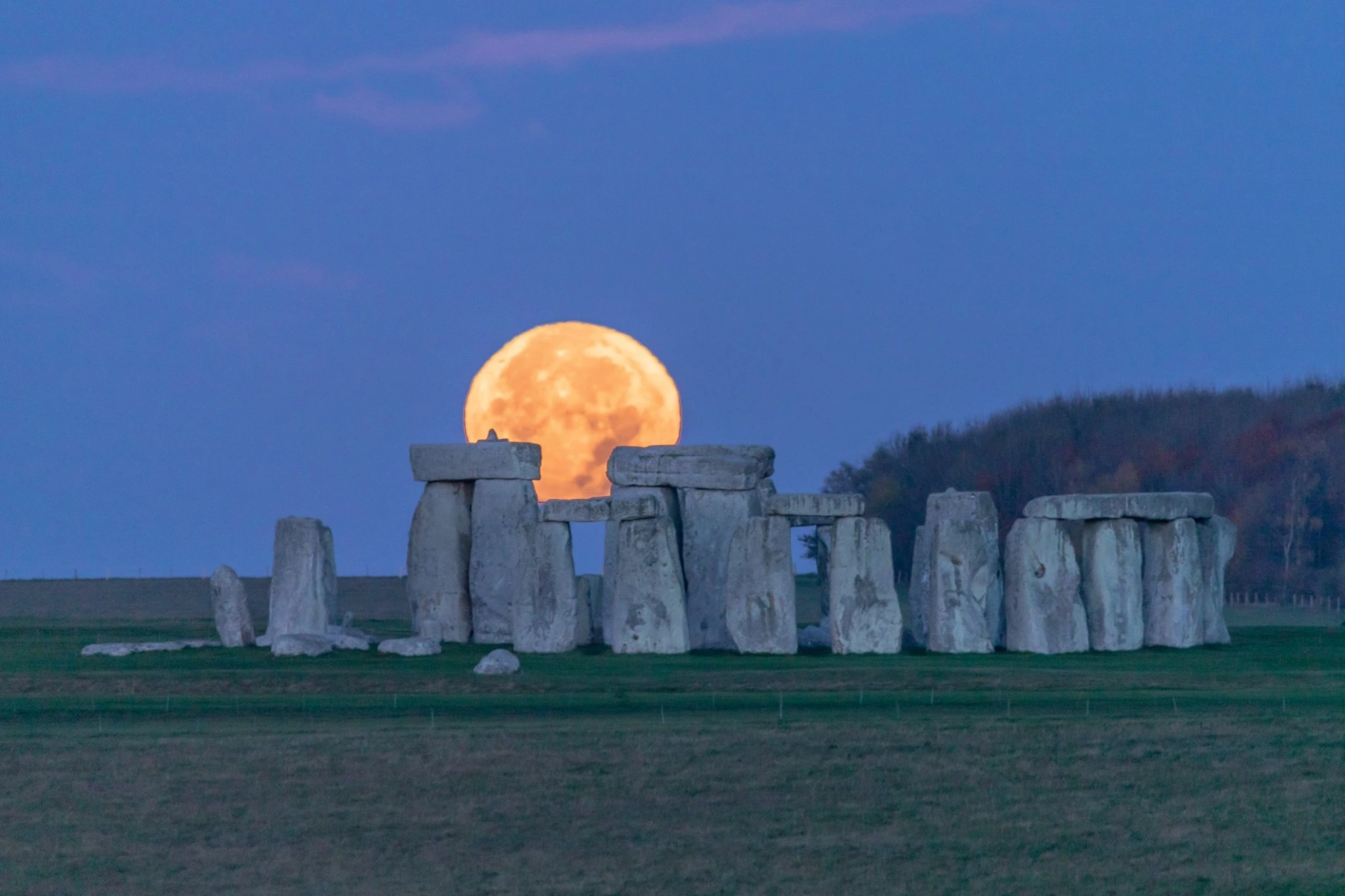
In addition, a large stone inside Stonehenge, called the “Heel Stone”, is a marker that indicates the northernmost and southernmost points of the Moon. By placing this stone, ancient communities with knowledge of the Moon’s movements could determine the lunar calendar and important rituals.
Historical and Scientific Importance
The astronomical features of Stonehenge show how advanced ancient people’s knowledge of astronomy and sky observation was. This structure is of great importance for both history and science and is an invaluable resource for understanding the past of humanity.
| Observations | Features |
|---|---|
| Sunrise | The Great Stone Line marking the sunrise |
| Sunset | The Great Stone Line showing the sunset |
| Movements of the Moon | The ability of stone rings to follow the movements of the Moon |
| Summer solstice | Stones marking the northernmost point where the sun rises |
| Winter solstice | Stones marking the southernmost point where the sun sets |
| Lunar calendar | Heel Stone marks the northernmost and southernmost points of the Moon |
Stonehenge and Druidism
Stonehenge has been associated with many mythological beliefs and legends throughout history. In particular, it is thought to have a connection with the Celtic religion called Druidism. Druidism is a belief system based on the cult of nature and is believed to have had an impact on Stonehenge’s survival.
Druidism refers to special people who took on the role of priests and sages in Celtic societies. They performed rituals to understand nature and universal energies, and held rites at sacred sites such as Stonehenge.
At the time Stonehenge was built, Druidism was an important religious and cultural element in Britain. For this reason, many theories and legends have emerged that Stonehenge was used by the Druids
Some of the special stones of the structure are thought to point to points where Druids are thought to have performed rituals and astronomical observations. This is one of the factors suggesting that Stonehenge has a relationship with Druidism.
The connection between the Druids and Stonehenge is one of the mysteries of Stonehenge, and even today it is not fully solved. This increases curiosity and research into the structure and emphasizes that Stonehenge has a mystical and magical atmosphere.
Restoration and Conservation of Stonehenge
The historical and cultural value of Stonehenge has necessitated intensive efforts to restore and protect this ancient structure and a number of measures have been taken. In this section, we will provide information about Stonehenge’s restoration work and conservation measures.
The restoration and conservation of Stonehenge involves a variety of restoration projects. These projects aim to mitigate the environmental impacts surrounding the monument, stabilize the stones and preserve the monument for future generations.
| Restoration Works | Protection Measures |
|---|---|
| Worn and damaged stones are repaired. | Protective fences have been erected around Stonehenge, allowing limited access. |
| Surface cleaning and painting processes are carried out. | Plant and animal species that can damage the structure are kept under control. |
| Archaeological excavations and research are being carried out and new findings about the structure are being obtained. | Educational programs and information signs have been prepared for visitors to Stonehenge. |
Restoration and conservation work aims to ensure that Stonehenge will remain intact and preserved for years to come. These efforts are important to pass on the value and history of this ancient site to future generations.
Stonehenge and Tourism
Stonehenge is a tourist attraction that has gained worldwide fame. Offering a fascinating experience for visitors, this ancient structure is of great importance for tourism. Thousands of tourists come here every year to visit Stonehenge.
Among the reasons for Stonehenge’s interest and the influx of tourists are its miraculous structure, its historical significance and its mysterious atmosphere. As visitors walk around this magnificent ring of stones, they are taken on a journey into the depths of the past. The mystical atmosphere of Stonehenge stimulates the imagination and curiosity of tourists.
The best way to visit Stonehenge is to take a guided tour and learn the story of this ancient monument. Guided tours provide visitors with detailed information about Stonehenge’s history, construction techniques and meaning. In addition, tourists can explore Stonehenge’s astronomical features and its relationship with the movements of the sun and moon.
Stonehenge is also rich in tourist amenities. Visitors can buy unique souvenirs in the gift shops and find jewelry and souvenirs representing Stonehenge. They can also sample local delicacies in the surrounding cafes and restaurants.
Stonehenge has great potential for tourism. We can say that this important historical monument offers an unforgettable experience for visitors.
Stonehenge Visitor Profile
Stonehenge is visited by local and foreign tourists. People of different age groups come here to visit this ancient site. In addition, specialized archaeologists, historians and students also visit the site to study and research Stonehenge.
| Profile | Tourists |
|---|---|
| Age Range | All age groups |
| Nationality | National and international visitors |
| Fields of Interest | History, archaeology, mythology, astronomy |
| General Profile | Adventurers, history buffs, researchers, students and families |
Stonehenge Legends and Folktales
There are many legends, folk tales and myths about Stonehenge. This ancient structure has provoked people’s imagination and interest for centuries. Here are some of the legends associated with Stonehenge
- Merlin’in Sihirli Gücü: Merlin’in, Stonehenge’in inşaatında sihirli güçlerini kullandığına dair bir efsane vardır. Bazı hikayelere göre, Merlin taşları büyüyle hareket ettirerek Stonehenge’i inşa etmiştir. Bu efsane, Stonehenge’in sıradışı yapısının arkasında gizemli bir gücün olduğu fikrini desteklemektedir.
- Tanrıların Dansı: Bir başka efsaneye göre, Stonehenge’in taşları, geceleri tanrıların dans ettiği zamanlarda kendiliğinden hareket etmektedir. Bu efsane, Stonehenge’in mistik ve büyülü bir yer olduğu inancını yansıtmaktadır.
- Druidlerin Ritüelleri: Stonehenge’in druidler tarafından kullanıldığına dair birçok hikaye vardır. Bu hikayelere göre, druidler burada ayinler düzenler ve mistik güçlerini kullanırlardı. Stonehenge, druidlerin mistik inançlarının merkezi olarak kabul edilir.
- Boşaltılan Mezarlar: Stonehenge’in içindeki mezarların ritüeller ve önemli olaylar için boşaltıldığına dair bir efsane bulunmaktadır. Bu efsaneye göre, Stonehenge’deki mezarlar, tanrıların ve önemli kişilerin onurlu bir şekilde geçiş yapmaları için boşaltılmıştır.
| Myth/ Folk Tale | Description |
|---|---|
| The Magic Power of Merlin | The legend that Merlin built Stonehenge by moving stones with magic. |
| Dance of the Gods | The legend that Stonehenge’s stones moved when the gods danced. |
| Rituals of the Druids | Stories and beliefs that Stonehenge was used by druids. |
| Emptied Tombs | The legend that the tombs at Stonehenge were emptied for rituals. |
Stonehenge and Modern Relevance
Stonehenge is not only an archaeological site or a historical monument, it has also been a major focus of interest in modern art, literature and popular culture. This ancient structure has fascinated and awe-inspired people for centuries and has been a source of inspiration for many artists, writers and filmmakers.
The magic and impressive appearance of Stonehenge has influenced many names in the art world. Stonehenge can often be seen in paintings, sculptures and photographs. This structure immerses them in a mystical atmosphere and offers a magical experience to its visitors.



However, it is also possible to see Stonehenge featured in modern literature. Many writers include references to Stonehenge in their works and some novels or stories are centered around the ancient structure. The mysteries, myths and history of Stonehenge feed the imagination of writers.
Stonehenge also frequently appears in popular culture. Stonehenge scenes are featured in various productions in the world of cinema and television. Especially in science fiction, fantasy or history-themed productions, Stonehenge is frequently featured. These productions excite audiences and bring the magic of Stonehenge to the screen.
Artworks Related to Stonehenge
| Artwork | Artist |
|---|---|
| Solstice | Maxime Leroy |
| Stonehenge #1 | Andy Goldsworthy |
| Stonehenge Summer Solstice | Steve Howdle |
| Stonehenge Room | Patrick Burensteinas |
The table above shows examples of some of the works of art based on Stonehenge. These works reflect the influence and interest of Stonehenge in the art world.
Structures Similar to Stonehenge
Stonehenge is known for its unique architecture and historical significance. However, there are many archaeological and historical monuments similar to Stonehenge around the world. These are fascinating monuments built by various cultures.
In this section, we will examine important structures similar to Stonehenge. These structures may have similar features to Stonehenge or may have been used for similar purposes. Here are some examples:
Gobekli Tepe
Göbekli Tepe is an archaeological site in the Şanlıurfa province of Turkey, dating back to 9600-7300 BC. Older than Stonehenge, Göbekli Tepe is recognized as the oldest known temple complex in the world. Filled with standing stones and statues, these structures may have been used by the people of the time for religious rituals.
Avebury
Avebury is a Neolithic settlement in Wiltshire, England. Located about 30 kilometers from Stonehenge, Avebury is notable for its large stone rings. These stone rings may have been an important center for social and religious interactions during the Neolithic period.
Karnak Temple
Karnak Temple is a large temple complex in Luxor, Egypt, dating from the time of the Egyptian Pharaohs. The massive columns, obelisks and statues in the Temple of Karnak were built to symbolize the religious and political power of the people of the time.
Chichen Itza
Chichen Itza is an archaeological site of the Mayan culture on the Yucatan Peninsula of Mexico. Like Stonehenge, Chichen Itza has astronomical features, pyramids, temples and special structures. These structures may have been used to represent the Mayan calendar and religious rituals.
These are just a few of Stonehenge’s analogues around the world. Each belonging to a different culture and period, they help us understand how people built and used things in the past.
Mysteries of Stonehenge
Stonehenge has brought many mysteries and controversies throughout history. Some of the features and purposes of this ancient monument are still not fully understood.
Meaning of the Surrounding Obelisks
The purpose of the obelisks in the immediate vicinity of Stonehenge is still a question mark. According to one theory, they may have been used for astronomical observations. However, exactly what observations they were used for and what they mean is still unclear.
Construction Technique
How Stonehenge was built and how these huge stones were moved is still a mystery. What methods were used to move these stones and how they were perfectly placed thousands of years ago is still a matter of debate.
“The construction of Stonehenge is fascinating given the technology and resources available at the time. It is truly astonishing to understand how this ancient monument was built with such precision.”
Purpose and Function
The original purpose and use of Stonehenge remains a mystery. According to one theory, it is thought to have been used as a calendar or a solar observation tool. However, this theory remains unproven and the true function of Stonehenge is still unknown.
Meaning and Spiritual Significance
The meaning and spiritual significance of Stonehenge is still a matter of debate. Some believe that this ancient monument has a mystical energy and was used for rituals. However, this theory is also unproven and the true spiritual meaning of Stonehenge remains unclear.
Stonehenge is full of mysteries, which makes this ancient monument even more attractive. People are still working to unravel its secrets and discover its true purpose.
Frequently Asked Questions About Stonehenge
Question 1: What is Stonehenge?
Stonehenge is an ancient Neolithic monument in Wiltshire, England. It is made of large stone blocks and horizontal stones laid in an orderly fashion. Dating back to the Neolithic and Bronze Age, it has triggered various theories about how and for what purpose it was used in ancient times.
Question 2: What is the construction date of Stonehenge?
Stonehenge was built between 3000 BC and 2000 BC. This coincides with the Neolithic and Bronze Age, and the process of building Stonehenge continued for many years.
Question 3: What was Stonehenge used for?
The exact purpose of Stonehenge is not known for certain. However, researchers believe that it may have been used for astronomical observations, religious rituals or social events.
Question 4: How was Stonehenge built?
How Stonehenge was built is still not fully understood. However, it is known that enormous effort was required to transport and place the stones. Some theories suggest that the stones were transported in boats down rivers and then overland.
Question 5: What is the architecture of Stonehenge?
Stonehenge consists of a series of structures characterized by large standing stones and horizontal stone rings. The main ring is a combination of standing stones and horizontal stones and has a complex structure of intertwined rings.
Question 6: Who built Stonehenge?
Who built Stonehenge remains a mystery. However, it is believed that it was the Neolithic communities of the region or their ancestors.
Question 7: How to get to Stonehenge?
Stonehenge is located in Wiltshire, England. The nearest major cities include London and Bristol. Visitors can reach Stonehenge by various transportation options such as car, train or bus.
Question 8: Can Stonehenge be visited?
Yes, Stonehenge can be visited. However, visitors need to purchase tickets in advance and can only visit during certain time periods. Also, for conservation purposes, visitors must not touch the stones and must follow designated paths.
Question 9: What kind of events are organized at Stonehenge?
A variety of events are organized at Stonehenge throughout the year. These include special tours, solstice and equinox events, archaeological excavations and cultural events. Visitors can access a calendar of events on the official Stonehenge website.
Question 10: What is the significance of Stonehenge in the world?
Stonehenge is one of the most famous prehistoric monuments in the world and marks an important period in human history. From astronomical observations to ancient religious practices and social organization, Stonehenge has been of great interest to researchers.
My Thoughts on Stonehenge
Stonehenge remains one of the most fascinating structures in human history. This ancient structure, which has been admired and explored by people for thousands of years, still holds many mysteries. Questions about how and why people built Stonehenge are still waiting to be answered. However, research and excavations show that this enigmatic monument could have been used for many different purposes.
It has been suggested that Stonehenge may have been used as a calendar for astronomical observations, a venue for religious ceremonies and rituals, or even for medical or educational purposes. But whatever the exact purpose for which it was built, it is a feat of engineering and cultural significance that still astonishes people today.
Preserving and researching Stonehenge for future generations is of the utmost importance. We believe that research and discoveries will continue to unlock the secrets of this ancient monument and shed light on humanity’s past. Stonehenge is not just a building, it is the common heritage of mankind, and the interest and curiosity to explore it never wanes.
If you haven’t read it yet, you can also check out our review of Taj Mahal – The Temple of Remembrance…
Architect: Unknown
Architectural Style: Megalithic
Year: 3000 BC – 2000 BC
Location: Wiltshire, England
Discover more from Dök Architecture
Subscribe to get the latest posts sent to your email.










